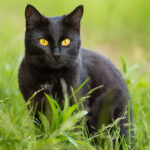Cats are captivating creatures, admired for their grace, agility, and enigmatic personalities. Beyond their varied coat patterns and playful antics, one of the most striking features of a cat is their eyes. Cat Eye Colors are incredibly diverse, ranging from brilliant blues to striking coppers, each hue adding to the unique charm of our feline companions.
In this article, we will delve into the fascinating world of cat eye colors. We’ll explore the spectrum of colors you might encounter, uncover the science behind what dictates these shades, and touch upon the potential links between eye color and feline health. Whether you’re a seasoned cat owner or simply an admirer of these beautiful animals, prepare to be mesmerized by the kaleidoscope of colors found in cat eyes.
Understanding the Structure of a Cat’s Eye
To truly appreciate the nuances of cat eye color, it’s helpful to understand the basic anatomy of their eyes. The color we perceive in a cat’s eyes is located in the iris. The iris is the colored ring of tissue that surrounds the pupil, the black central circle that expands and contracts to regulate light intake.
Think of the iris as a natural aperture, similar to that in a camera lens. Its primary function is to control the size of the pupil, thereby managing the amount of light that reaches the retina at the back of the eye. This regulation is crucial for vision in varying light conditions.
The iris itself is composed of two main layers:
- Stroma: This is the frontmost layer of the iris. It’s made up of connective tissue, blood vessels, and specialized cells called melanocytes.
- Epithelium: Located behind the stroma, this layer also contains melanocytes.
The magic of eye color lies within these melanocytes and the pigment they produce.
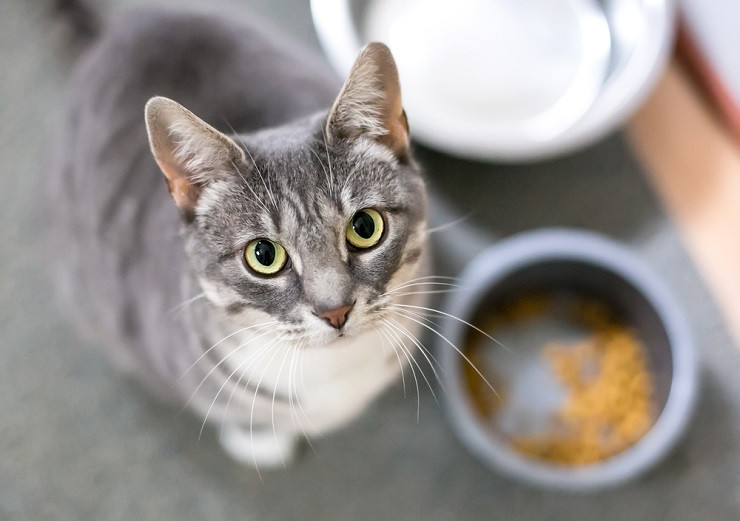 Close-up of a cat making eye contact, highlighting the iris and pupil
Close-up of a cat making eye contact, highlighting the iris and pupil
The Role of Melanin in Cat Eye Color
The secret behind the vibrant spectrum of cat eye colors is melanin. Melanin is a pigment produced by melanocytes and is responsible for coloration in not just eyes, but also skin and hair in both humans and animals, including cats.
The amount and type of melanin present in the iris determine the resulting eye color. Melanocytes produce two main types of melanin:
- Eumelanin: This pigment produces black and brown colors.
- Phaeomelanin: This pigment produces red and yellow colors.
In cat eyes, eumelanin is the primary pigment at play. The density of melanocytes and the amount of eumelanin they produce directly correlate with the darkness and intensity of the eye color.
- High Melanin Concentration: More active melanocytes producing a greater quantity of melanin result in darker eye colors like copper, amber, or deep gold.
- Low Melanin Concentration: Less melanin leads to lighter shades such as green or yellow.
- Absence of Melanin: The complete absence of melanin results in blue eyes. Interestingly, blue eyes are not actually pigmented blue. Instead, the blue color is an optical illusion. It’s caused by the way light scatters off the collagen fibers in the stroma of the iris when there is no melanin present to absorb the light. This is similar to how the sky appears blue.
Kitten Eye Color Development: From Blue to Permanent Shades
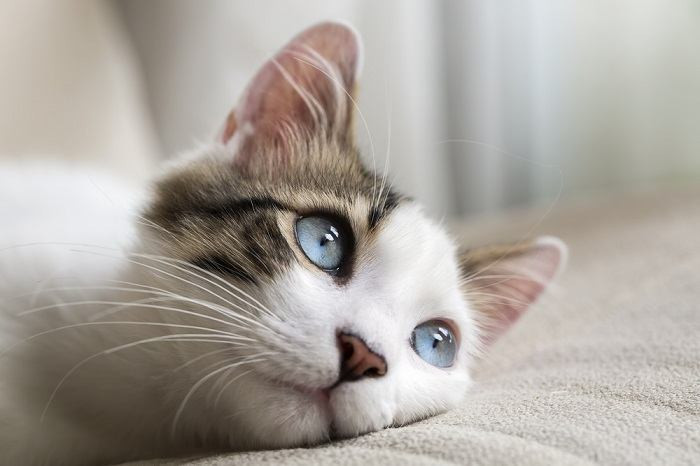 A blue-eyed kitten looking directly at the camera
A blue-eyed kitten looking directly at the camera
Kittens are born with their eyes closed, and when they finally open around 8 to 12 days after birth, they almost universally have blue eyes. This “kitten blue” is due to the delayed production of melanin in the iris. At this young age, melanocytes haven’t yet fully kicked into gear.
However, this charming blue hue is temporary. As kittens grow, their melanocytes start producing melanin, and the true, permanent eye color begins to emerge. This transition usually starts around 6 weeks of age.
By the time a kitten is around 3 to 4 months old, their permanent eye color is typically established. Observing eye color change can be a helpful, albeit not precise, method for estimating the age of a young kitten if their birthdate is unknown.
Exploring the Diverse Palette of Cat Eye Colors
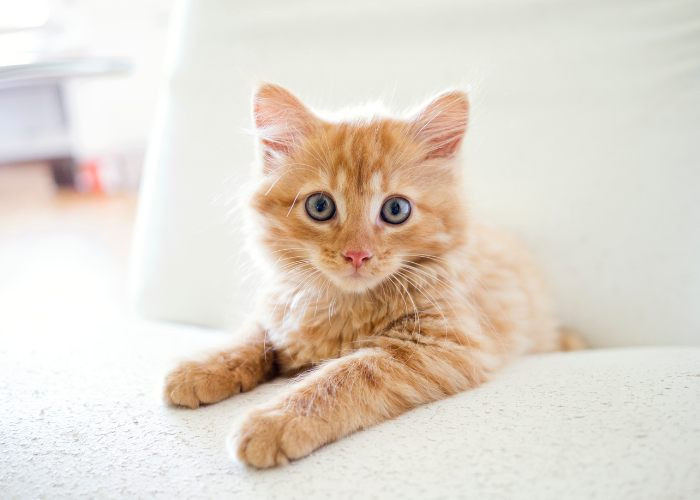 A variety of cats with different eye colors sitting together on a chair
A variety of cats with different eye colors sitting together on a chair
Now that we understand the science behind cat eye color, let’s explore the beautiful array of colors you might encounter. While there can be subtle variations and overlaps, we can categorize cat eye colors into several main groups:
1. Blue Eyes: The Melanin-Free Marvel
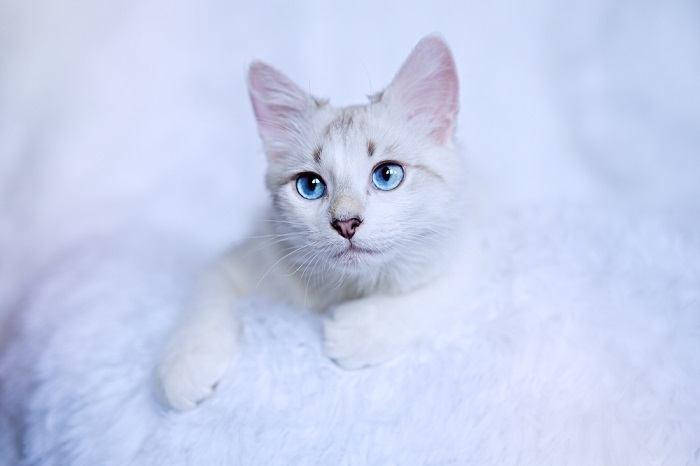 Close-up of a cat with piercing blue eyes
Close-up of a cat with piercing blue eyes
As mentioned, blue eyes in cats signify a complete lack of melanin in the iris. This lack of pigment allows the scattering of light to create the blue appearance.
Blue eyes are commonly seen in certain cat breeds, notably:
- Siamese: Famous for their striking blue almond-shaped eyes.
- Ragdoll: Known for their large, captivating blue eyes.
- Himalayan: Sharing ancestry with Persians and Siamese, they often have blue eyes.
- Birman: Sporting sapphire blue eyes that contrast beautifully with their pointed coats.
2. Green Eyes: A Touch of Melanin
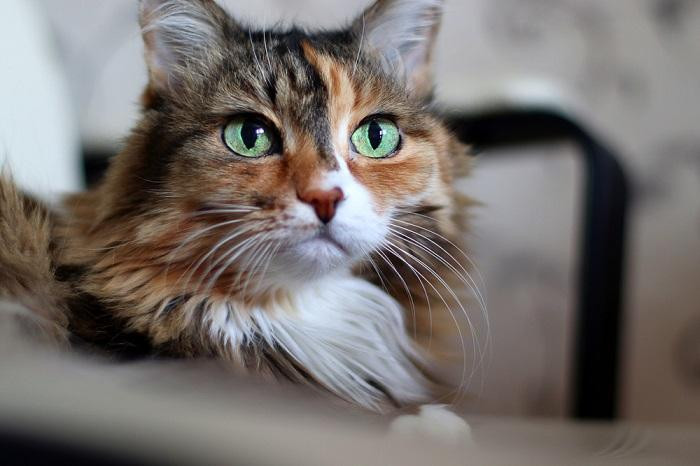 A cat with captivating green eyes staring intently
A cat with captivating green eyes staring intently
Green eyes indicate a small amount of melanin present in the iris. The low concentration of pigment interacts with light to produce the verdant shades we admire.
Green eyes are found in various cat breeds and are particularly associated with:
- Egyptian Mau: Known for their striking gooseberry green eyes.
- Russian Blue: Famous for their vivid green eyes that complement their silver-blue coat.
- Abyssinian: Often possessing mesmerizing green or gold eyes.
- Bengal: While their eye color varies, green is a possible and beautiful shade.
3. Yellow, Orange, Amber, and Gold Eyes: Increasing Melanin Intensity
 A cat with bright yellow eyes looking directly at the camera
A cat with bright yellow eyes looking directly at the camera
Moving along the spectrum, yellow, orange, amber, and gold eye colors represent increasing levels of melanin in the iris. These warm and inviting shades are quite common in cats and often described as “golden eyes” in general conversation.
The specific shade within this range depends on the precise amount and distribution of melanin. You might see:
- Yellow: A brighter, more lemon-like yellow.
- Orange: A deeper, more saturated orange hue.
- Amber: A warm, tawny shade, sometimes with hints of brown.
- Gold: A rich, lustrous golden color.
These warmer eye colors are seen across a wide variety of cat breeds and coat colors, making them a frequently encountered and much-loved feature.
4. Copper Eyes: The Deepest Shade
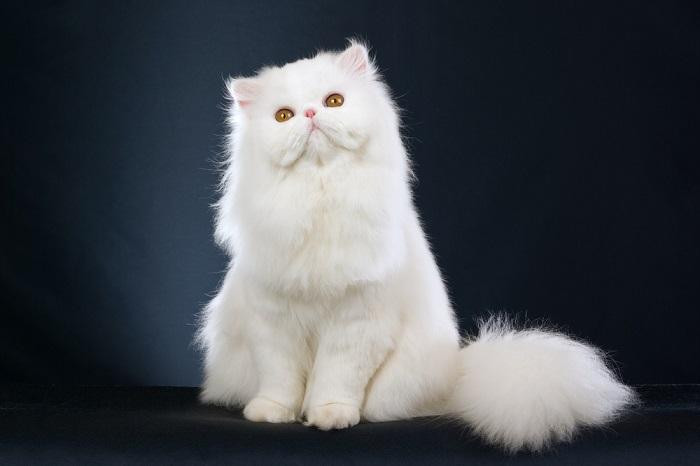 A cat with intense copper-colored eyes looking slightly to the side
A cat with intense copper-colored eyes looking slightly to the side
Copper represents the darkest end of the typical cat eye color spectrum. These eyes possess a high concentration of melanin, resulting in a deep, rich orange-brown hue that can sometimes appear almost reddish in certain lighting.
Copper eyes are considered relatively rare and are particularly striking. They are notably associated with breeds like:
- British Shorthair: While their eye color varies, copper is a recognized and admired shade in this breed.
- Persian: Some Persians can exhibit copper eyes, adding to their luxurious appearance.
5. Heterochromia: Eyes of Different Colors
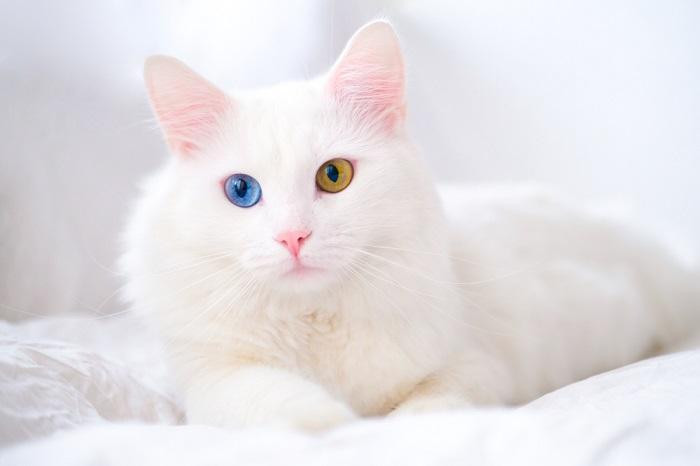 A cat with heterochromia, showing one blue eye and one different colored eye
A cat with heterochromia, showing one blue eye and one different colored eye
Heterochromia, also known as “odd-eyed,” is a captivating condition where a cat has two different colored eyes. This occurs due to varying amounts of melanin in each iris. One eye is typically blue (lack of melanin), while the other eye can be green, yellow, amber, or copper.
Complete heterochromia, where each eye is a distinctly different color, is most frequently observed in white cats. This is because the gene responsible for white coats can also influence melanin distribution in the eyes.
6. Sectoral Heterochromia (Dichromatic Eyes): Colors Within One Iris
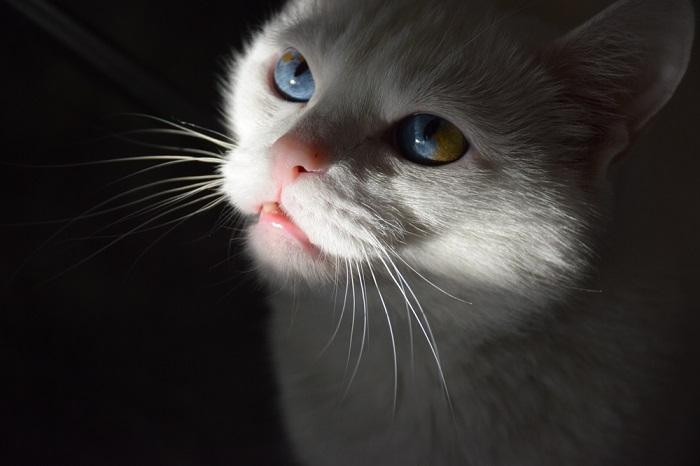 A cat with sectoral heterochromia, showing two colors within the same iris
A cat with sectoral heterochromia, showing two colors within the same iris
Less common than complete heterochromia is sectoral heterochromia or dichromatic eyes. In this case, a single iris displays two distinct colors. This can manifest as patches or sectors of different colors within the same eye. For instance, you might see an eye that is predominantly green with a segment of yellow or blue.
7. Red Eye Shine: The Tapetum Lucidum Effect
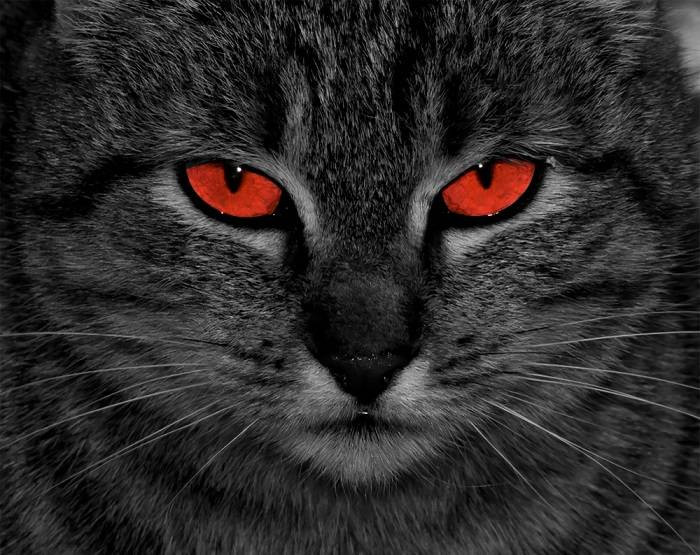 A cat with blue eyes exhibiting red eye shine in a dark setting
A cat with blue eyes exhibiting red eye shine in a dark setting
While cats don’t have visibly red irises, blue-eyed cats can exhibit a red “eye shine” in photographs taken in low light conditions, especially when using a flash. This phenomenon is due to the tapetum lucidum, a reflective layer behind the retina that enhances night vision by reflecting light back through the retina.
In cats with non-blue eyes (those with melanin), the tapetum lucidum typically produces a green or yellow eye shine. The red shine in blue-eyed cats is again related to the lack of melanin, allowing more of the red wavelengths of light to be reflected.
Eye Color and Potential Health Considerations
While most cat eye colors are purely aesthetic and harmless, there are a few connections to potential health concerns to be aware of:
-
Blue Eyes and Deafness in White Cats: The link between blue eyes and deafness in white cats is well-documented. The W gene, responsible for a completely white coat, is also associated with congenital deafness, particularly in cats with blue eyes. White cats with two blue eyes have a significantly higher risk of being deaf compared to white cats with non-blue eyes or non-white cats. BAER (Brainstem Auditory Evoked Response) testing can diagnose deafness in cats.
-
Copper Eyes and Liver Shunts: In rare cases, copper-colored eyes, especially when accompanied by other symptoms, can raise suspicion of a liver shunt (portosystemic shunt). This is a condition where blood flow bypasses the liver, preventing proper detoxification. Symptoms may include poor growth, vomiting, diarrhea, weight loss, disorientation, and seizures. It’s crucial to consult a veterinarian if you observe these signs in a cat with copper eyes.
The Relationship Between Eye Color and Coat Color
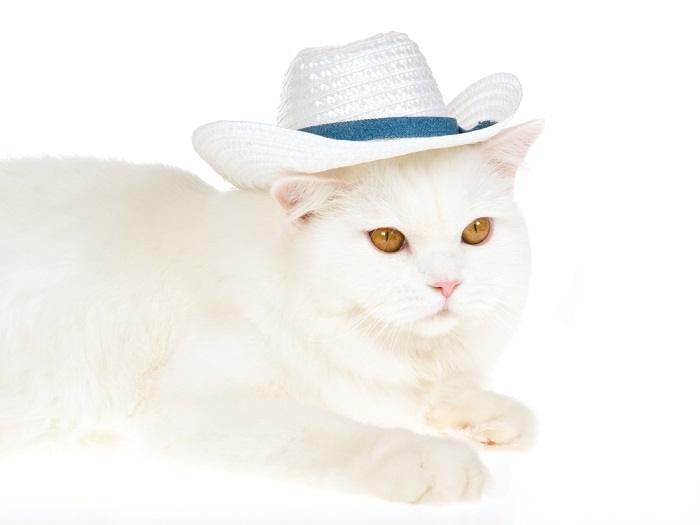 A white cat wearing a cowboy hat, demonstrating the link between white coats and blue eyes
A white cat wearing a cowboy hat, demonstrating the link between white coats and blue eyes
Interestingly, unlike in humans where hair and eye color are often linked, in cats, coat color and eye color are generally independent of each other. A black cat (high melanin in coat) can easily have green eyes (low melanin in iris), for example.
The primary exception to this rule is, again, white cats. As discussed, the W gene not only produces a white coat but also increases the likelihood of blue eyes and potential deafness. Therefore, in white cats, there is a notable correlation between coat color and eye color.
When Cat Eye Color Changes Signal a Problem
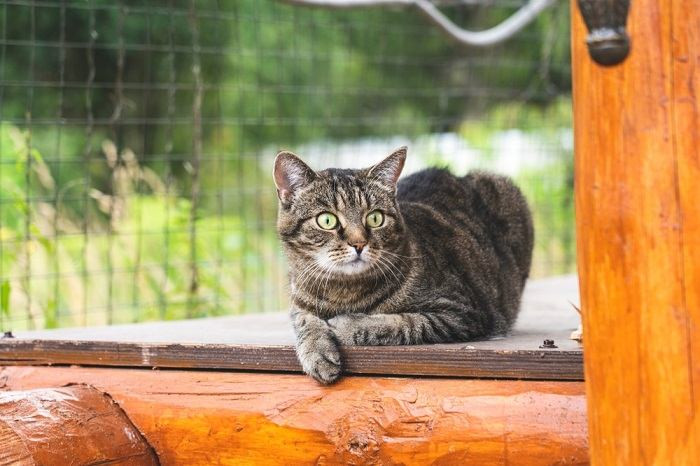 A cat looking out a window, highlighting the importance of observing changes in eye color
A cat looking out a window, highlighting the importance of observing changes in eye color
As we know, kitten eye color naturally changes from blue to their permanent color within the first few months of life. However, any eye color change after 3-4 months of age is considered abnormal and warrants veterinary attention.
Sudden changes in eye color in adult cats can be a symptom of various underlying medical conditions, including:
- Trauma: Injury to the eye can cause inflammation, cloudiness, or bleeding within the eye (hyphema).
- Infections: Viral or bacterial infections can lead to eye inflammation (uveitis), ulcers, and changes in appearance.
- Systemic Diseases: Conditions like diabetes (leading to cataracts), high blood pressure (causing retinal detachment and pupil dilation), and Feline Infectious Peritonitis (FIP) can affect eye color and appearance.
- Eye Tumors: Tumors within the eye, such as melanomas of the iris, can cause color changes, enlargement, or deformity of the eyeball.
Seek immediate veterinary care if you observe any of the following in your cat’s eyes:
- Change in iris color
- Cloudiness or opacity
- Redness or bloodshot appearance
- Changes in pupil size (unequal pupils or persistently dilated/constricted pupils)
- Eye enlargement
- Discharge from the eye
- Signs of eye pain (squinting, pawing at the eye)
While the spectrum of cat eye colors is a beautiful aspect of feline diversity, it’s essential to be aware of both the normal variations and when changes might indicate a health issue. Regular observation of your cat’s eyes and prompt veterinary attention for any concerns will help ensure their continued health and well-being.
Frequently Asked Questions About Cat Eye Colors
What are the main colors of cat eyes?
Cats exhibit a range of eye colors, primarily blue, green, yellow, orange, amber, gold, and copper. They can also have heterochromia, with two different colored eyes, or sectoral heterochromia, with multiple colors in one iris.
What is it called when a cat has two different colored eyes?
This condition is called heterochromia or complete heterochromia. These cats are often referred to as “odd-eyed cats.”
Do cats have brown eyes?
Cats technically do not have brown or black eyes. The darkest shade they achieve is copper, which can sometimes appear brownish in certain lights due to its deep orange-brown hue.
Is it true that white cats with blue eyes are often deaf?
While not all white cats with blue eyes are deaf, they have a significantly higher predisposition to congenital deafness compared to cats with other eye colors. This is due to the genetic link between the white coat gene and hearing impairment.
At what age do kittens’ eyes change color?
Kittens are born with blue eyes, which begin to change to their permanent color around 6 weeks of age. Their adult eye color is typically established by 3-4 months old.

